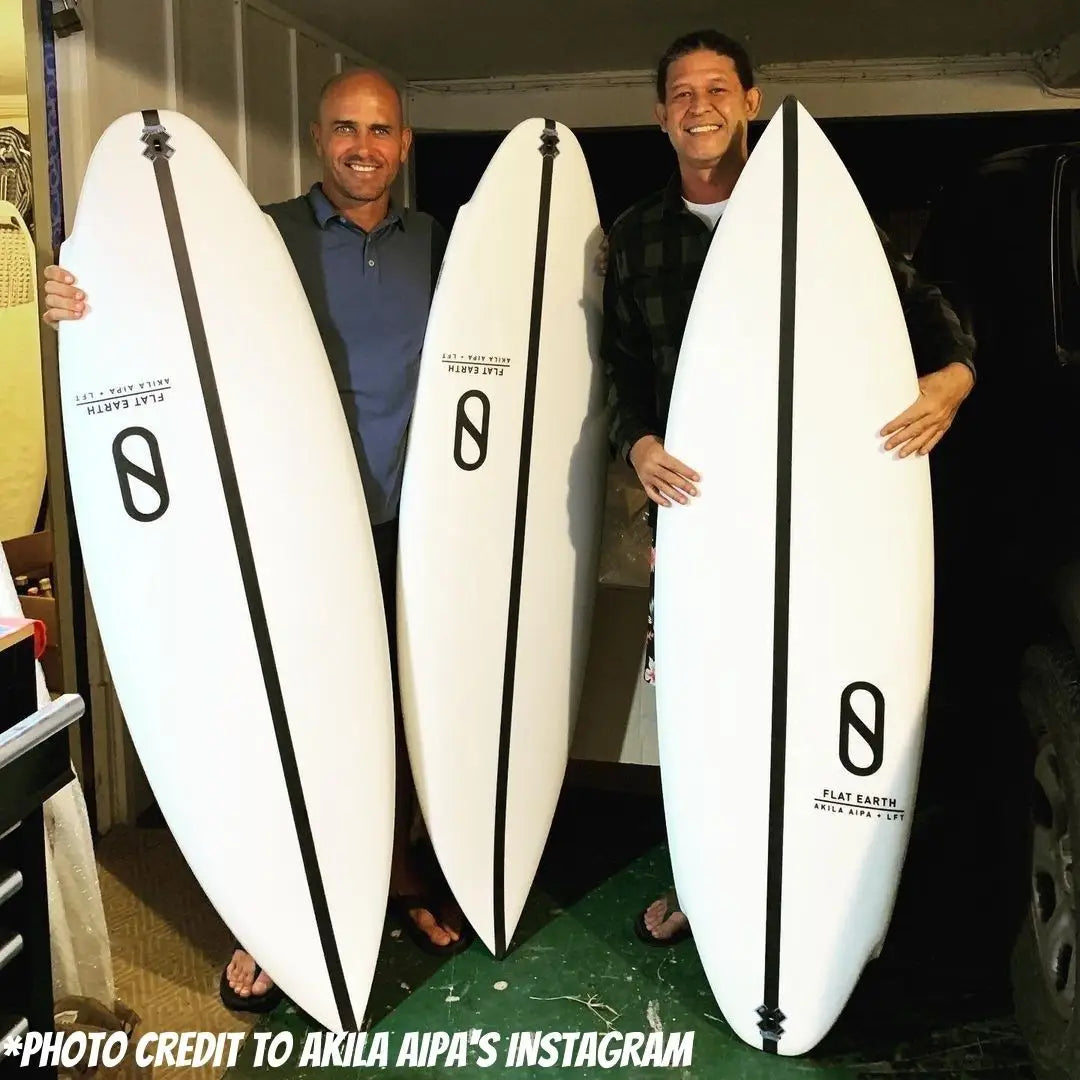Hawaiian South Shore February 2021 Newsletter
Share
NEWSLETTER FEBRUARY 2021

The Slater Connection—How Akila Aipa Became a Household Name
Akila Aipa was content to quietly create beautiful, custom boards in the Waialua Sugar Mill, without much fanfare or hype. But when you are a master craftsman (and an excellent surfer with an undeniable pedigree, to boot), people will eventually begin to take notice.
A few years back, Kelly Slater (which is from the same generation of pro surfers as Akila) asked Akila if he would like to collaborate on a quiver of boards, to see if they couldn’t dial in something special.
Akila ended up shaping seven boards for Slater—a handful of thrusters
between 5'7" and 5'9", and a 5'5" twin-fin. Slater ended up surfing the boards in a number of events, and putting together amazing performances at Keramas and the Surf Ranch—and just like that, Akila’s name was on the map.
From there, things started happening quickly. Demand for Akila’s boards skyrocketed, and suddenly he couldn’t keep up with demand from his small shaping bay in Waialua.
He started looking for a larger area to produce boards, and at the same time began dialing in a twin-fin board to add to Slater Design’s quiver of models, produced by Firewire.
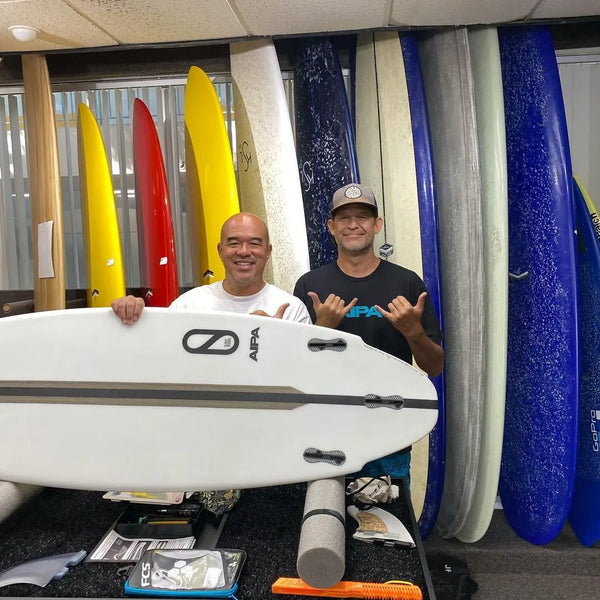
Addicted to the feeling
Flying on a foil have many coming back for more
I’ve been interested in learning to foil for awhile now, but it’s such a difficult sport to learn that I’ve never gotten out to give it a whirl. But that all changed the other day, when my friend Daniel Kaahanui and his business partner Mike Coleman took me out for a foil lesson. I ended up spending a couple of hours behind a ski, trying to get the board to lift up on the foil and “fly”—very challenging, but also super fun and very satisfying during the fleeting moments that I was able to maintain lift!
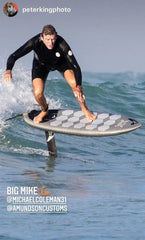
Mike and Daniel were great instructors, and have started teaching foil lessons on the side to help generate some extra income and “support their waterman lifestyle,” as Mike puts it. Mike is a substance abuse counselor and Daniel worked as a concierge at a hotel before COVID-19 hit, but their real passion is in the water. Daniel enjoyed a career as a professional surfer, and Mike is a lifelong surfer who transitioned to foiling three years ago, and never looked back! They SUP foil, prone foil, tow foil, and even wing foil!
Mike and Daniel do private lessons out near Sand Island, where they are allowed to run the ski on the flat water in the channel near the runway, which provides perfect conditions for learning. Typically they will give beginners classes behind the ski in flat water, as that is the easiest way to learn to fly the foil. But they also take more experienced wind surfers and kiters who have been on foil boards out into waves and teach them to tow surf, which Mike says is incredibly addicting.
Mike has 300 hours on the ski, with lots of experience towing in the ocean,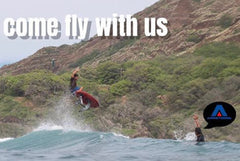
and Daniel is a great hands-on teacher who draws on his experience as a professional surfer and one of the best foilers on Oahu to help beginners figure out the basics. They provide everything for their students, from helmets and floatation vests to the ski, rope, boards, foils, and mast. Beginners will typically go out on a 7'6" Jimmy Lewis board that is 5.5 inches thick and 32 inches wide—in other words, it’s super stable. They like to start people off on a 28-inch mast for added control, as a shorter mast keeps you closer to the water. They combine this with a 220 Go-Foil with a 17.5 back flip tail, which provides a super smooth ride (or at least as smooth as beginning foiling gets!) A 30-foot tow rope puts the students far enough behind the ski that the foil won’t be upset by cavitation from the wake once they are able to get it to lift and start flying!
Foiling is definitely one of the hardest things I’ve ever tried, but it is also incredibly fun, especially once you start to get the hang of it. I can definitely see how people get so addicted to the feeling. Some people even stop surfing altogether because they are have so much fun foiling!
If you are interested in learning to foil, I definitely recommend heading out to Sand Island with Mike and Dave. You can contact them directly by phone.
Mike Coleman: (808) 723-9769
Daniel Kaahanui: (808) 542-9273
IG : @hi_wingfoiler
Member of the Month - Ezra Rod
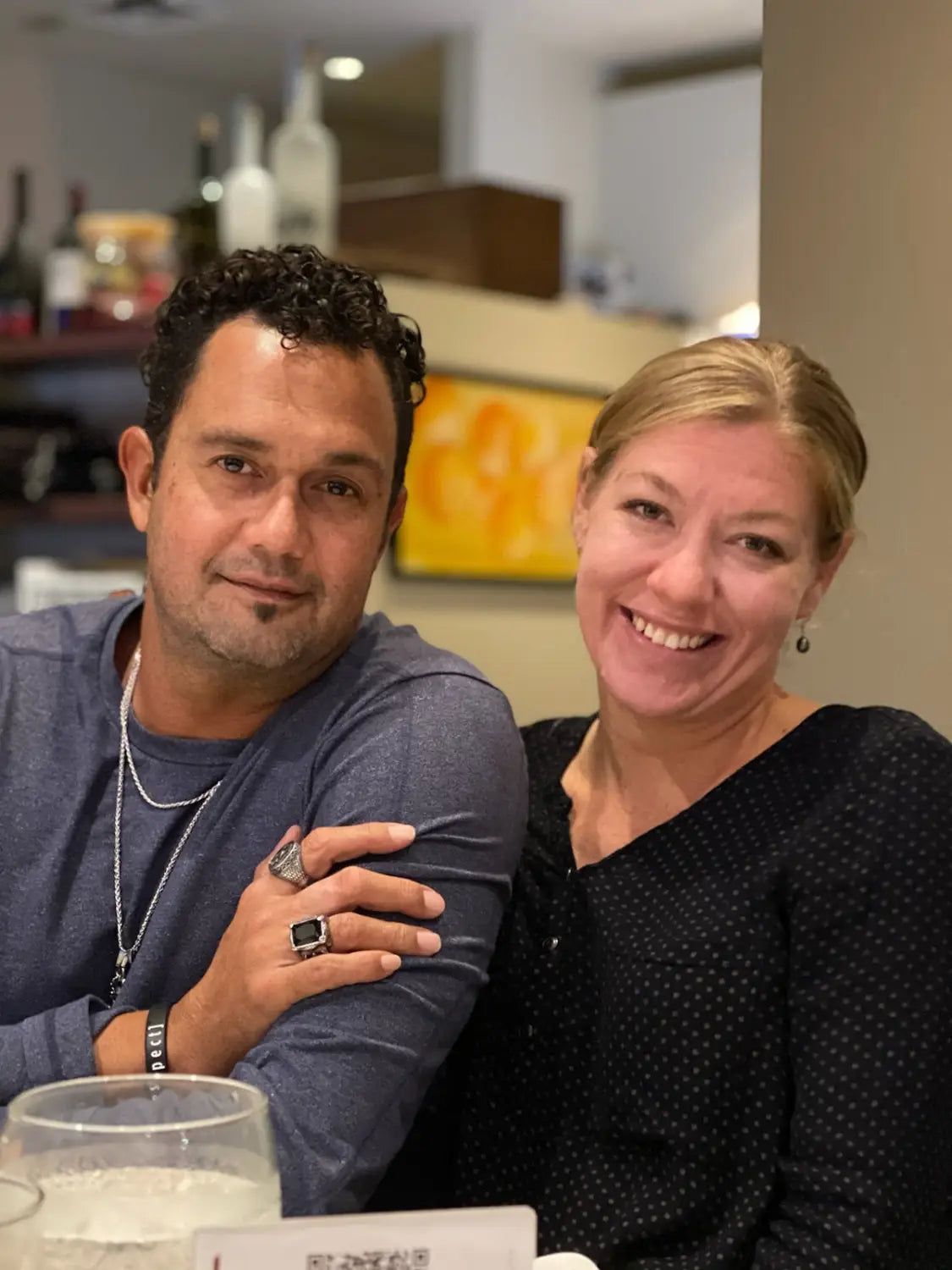
When and why did you initially get into surfing?
I initially got into surfing in Waikiki because my dad was an old time beach boy. He raised me down there in the 80s and there were a lot of cool kids that surfed really well. Randle Paulson, Megan Abubo, John Paul Kaleopaa and a bunch of other hot kids would come through and surfed the events and stuff.
I really admired watching them from the beach stands. That's what I did all day, every day, try to surf like the kids out there and I fell in love with surfing.
Did you have a time period you laid off from surfing? If so, when and why did you start back up?
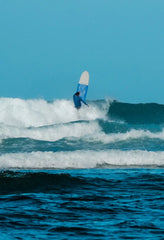
Surfing is a big thing in my life so the only time I don’t surf is if I’m really injured! I can remember the last major time I could not surf was when I had a spontaneous pneumothorax. I collapsed my lung surfing big Sunset. I didn’t do that often, so when I got held down, I popped my lung.
I didn’t notice until I got to work the next day working with a nail gun, I realized that I’d had a shortness of breath. That injury kept me out of the water probably the longest ever, 3 months of no surfing. It was misery! Haha
What is your favorite thing about surfing?
Everything about surfing is my favorite! Initially catching that wave and pouring your feelings out into that open face of each wave at the end of the day is one of my favorite feelings. Or I’d say, just surfing with friends and family is my favorite lifestyle! For me it’s everything I do. If I’m not working, I’m surfing.
You know catching a swell that hits the reef properly takes you all the way in. where you ride it from the beginning to the end, and you just do what you do on every wave during your session. That's one of my favorite things about surfing, it gives you the best feeling at the end of the day or it’s how you start your day! I like to call it wetting your gills, and for me it is a must!
Where is your favorite place to eat after surfing? What is your favorite item on the menu?
I wouldn’t say I frequently go anywhere in particular, I’m kind of a grab and go guy. I like to go to all the local spots, you know Sekiya’s, Rainbows, I like Ruger Market too. I really love Papa Oles when I’m on the North Shore side, I’ll drive to the Eastside just to go eat their Palehu ribs and squid luau. I love those and everything else on their menu!
What other hobbies do you have besides surfing?
I do woodworking for the State of Hawaii right now, carpentry is definitely a skill I’ve acquired. I skateboard with my kids. I’m basically a family man when I’m not surfing and its kind of like my main hobby. I like to draw too sometimes when the art supplies are out on the table. When I’m not at work or not with the kids or family, I’m surfing. I enjoy talking to friends and clients about the boards I ride too. Lately that’s been becoming a big hobby.
What type of work do you do?
Well like I said I'm a woodworker, so right now I’m the carpenter that runs the downtown area for the State. I’ve been with them almost 5 years now as well. I’ve been woodworking all my life, so basically doing that when I was not traveling!
My dad always told me if you’re going to do this professional surfing thing, you need something to fall back on. He’s an old timer, haha and their era which where all infamous and strict about having a plan for yourself pushed me to learn something besides surfing. I went through all the trades, from laying tile, to doing marble floors. I learned professional painting, drywall hanging and carpentry framing.
Eventually learning all the way to finish carpentry where I can say we built a ton of killer spots in and around Oahu and the Big Island. I’m very proud of that work !! The State stuff, I can get frustrated at times because it’s hard working with a team that I’m a little over qualified for, but the overall benefits for myself and family make it a good job !!
Tell us about the Thunderbolt boards you’ve ridden. What model and size is it, and how do you like its performance? What’s different about the ride compared to a regular Poly?
Thunderbolt. Well Thunderbolt came into my life about five years ago when Mr. Sumitomo, Yu Sumitomo gave me a phone call that began my journey with the Thunderbolt team.
A good friend of mine that I’ve surfed professional longboards with for years, Kapono Nahina, gave me the original call that told me I needed to try this construction.
I went to Hawaiian South Shore and that’s when I started my relationship with Dave. His awesome staff down there set me up and I tried my first Thunderbolt Harley Ingleby HIHP model designed by Billy Tolhurst. It changed my life and opened my eyes to the details within board construction. That was a serious turning point that really got me back into surfing again. I was enjoying everything about it like when I was full throttle professionally. The support got me motivated again and back to feeling excited about doing things in the surf industry!
So right now the models I ride, they’re all good haha I don’t know where do I start. I basically ride the Harley Ingleby series and it’s become my absolute favorite. Harley’s 9’1 HIHP model in full carbon is the one, that you know, really sparked my interest.
Then his HI4 model the brother the of that model, that’s another favorite of mine. Why, because they’re probably the best longboard shapes I’ve ever ridden. I’ve been through a lot of shapers in this industry with the polyurethane. You know what really sucks, it’s when you pull your leash and 3 feet of your tail comes back to you broken!
Being a professional longboarder from the 90s into the early 2000s, boards were just breaking and we’d spend a lot on fixing them. If you didn’t get a good board sponsor back in the day, I mean you know you’re paying out of your pocket to try and mend your longboards together for competition.
In Hawaii a lot of guys that I was raised around: Bonga, Dino Miranda, Duane Desoto and Rusty Keaulana, those guys, and when you hear a guy say oh you know it’s a longboard kind of day- I mean, you can throw that shit out the window because these guys are and were the modern progression of Hawaiian modern longboards.
They love surfing waves of consequence and that’s what they’ve taught all of us in my generation. You can ride a longboard on anything and make it work, but what Yusan and his team at Thunderbolt have been doing with boards is absolutely amazing. The equipment is next level. The eight stage construction has never been done before and the feeling I get when I ride these boards is one of confidence. I enjoy the speed, flex the strength or durability and once you’re hooked, it’s just... you know there’s nothing that compares to these boards. I’m very excited and grateful. I’ve been sharing this with friends and family, clients.
I mean this board family has opened up my world even locally because I get to talk to everybody in the water and even internationally with feedback. For me that’s what it’s all about now. Promoting with the Thunderbolt family and Dave store which is exclusively selling these boards. It’s been an amazing adventure and still super thankful to live the lifestyle.
Do you have any additional comments?
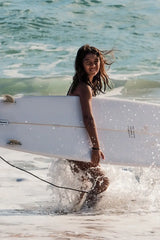
Thank you again Dave, and all of your ohana at Hawaiian South Shore for
always thinking of me and taking good care of me and my family. We absolutely love all your products. It's been fun working with you and I’m looking forward to what FireWire and Thunderbolt continue to produce in the future. I mahalo you guys very much!! Haha oh and go check out their wetsuits, and all their gear … so some of my favorites!!
Rice Versus Quinoa
A Low-Carb, Protein-Rich Alternative to Our Favorite Side Dish
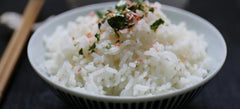
Having spent most of my life living in Japan and Hawaii, rice has always been a big part of my diet. Like most of my friends and family, I love rice! It’s the ultimate comfort food—a perfect complement to other dishes, and heavy in delicious carbohydrates. But that also makes it sort of unhealthy, because it’s easy to eat a lot of it, and excessive, unused carbohydrates typically end up turning into fat.
For that reason, I’ve lately been exploring using brown rice instead of white rice. Brown rice contains the husk, germ, and bran of the rice grains, which include lots of fiber and nutrients, whereas white rice is basically just empty, starchy calories. This is similar to white bread or other white flour products (such as pancakes) versus whole-wheat breads and pancakes, which contain a lot more fiber and nutrients as well.
Brown rice has a different flavor than white rice—sort of nuttier, earthier, and
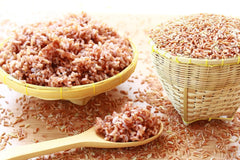
more wholesome—and takes some getting used to. But once you become accustomed to it, it’s actually quite delicious! Of course, there are certain dishes that simply go better with white rice—things like sushi and poke, for instance. But generally speaking, brown rice is a healthy, delicious substitute for white rice that has a lower glycemic index and helps regulate blood sugar.
Another alternative to rice that is arguably even healthier is quinoa. This seed from Peru can be used as a grain, and is quite popular in health food stores and healthy restaurants. The reason it’s so popular is that it has far fewer calories and carbohydrates per serving than rice, and way more protein.
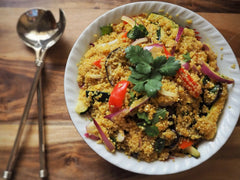
A cup of white rice actually has 40 more calories and more carbohydrates than a cup of quinoa, while that same cup of quinoa contains twice as much protein and five more grams of fiber than the rice. This makes quinoa much better in terms of calories consumed, glycemic index, muscle repair, and digestive health. The protein and fiber also help fill you up faster, so you will likely end up eating less food during your meal, which helps to regulate your weight. Finally, quinoa contains a complete protein, which means it has all nine essential amino acids. This makes it a great protein source for vegetarians and those looking to cut down on their intake of animal products.
Of course, for those who haven’t eaten quinoa their whole lives, it does take some getting used to. Like brown rice, it has an earthier, nuttier flavor, and the seeds are a bit smaller and less sticky than white rice grains.
But those who have grown to love it swear that quinoa is far superior to rice, both nutritionally and in terms of flavor. Next time you are at the grocery store, grab a bag of quinoa, throw it in the rice cooker same as you would with rice, and cook it up. Who knows—you just find that you like it better than rice!
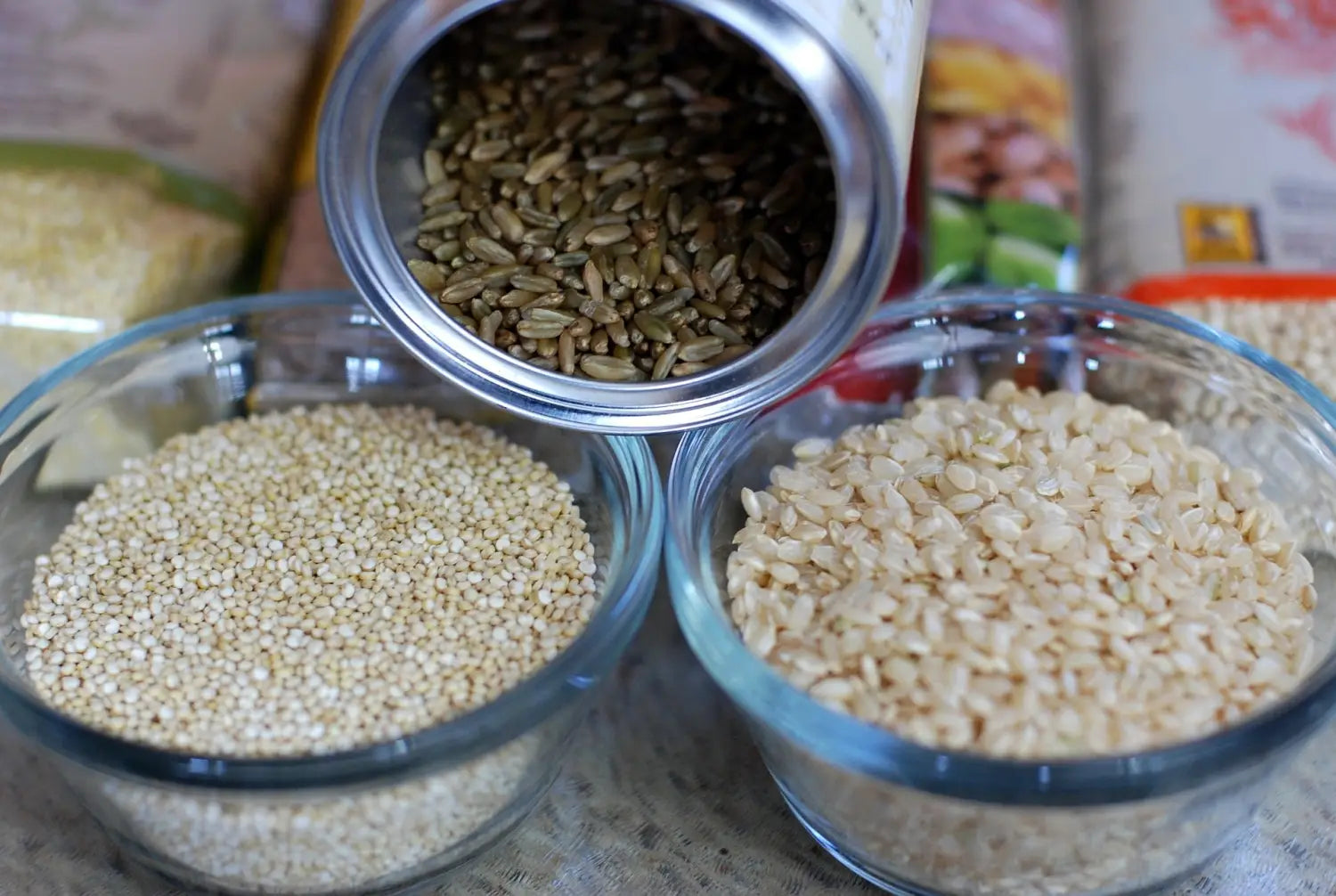
The SEVEN Forms of REST and Why They Are Important
As athletes who tend to pursue their sport on a daily basis, surfers have a number of recovery needs, including proper nutrition and rest.
But do you ever feel like no mater how much sleep you get, you are still exhausted? That’s because there are actually seven different types of rest that people need.
The first is obvious—and one that we talk about a lot. Physical rest is just as

important as physical activity, even for professional-level athletes who do endurance sports and other activities that require a lot of training. As it turns out, physical training is basically pointless unless you give your body the opportunity to recover and repair itself after the training—and that typically involves adequate sleep and days off from training so that your bodily systems can rebuild and become stronger. Physical rest can include passive rest (such as sleeping) as well as active rest (such as yoga, massage, and stretching).
But physical rest is only a small part of the equation. Mental rest is also important, because the brain controls your body’s hormones, and stress hormones such as cortisol can have a deleterious affect on your body. The best way to rest your mind is to take breaks every hour or two while working and engaging in mentally challenging projects. The Pomodoro technique is a great way to do this. In the Pomodoro technique, you schedule yourself 25-minute blocks to work on projects, and then five minute rests after every 25-minute block. Then, after doing four or five cycles, take a longer, 20-minute break.

Sensory rest is also important, especially in our modern Internet age when we have devices with us all the time. The light from our devices can interfere with the production of melatonin, and the stress of constant communication and stimulating media can interfere with mental quietude and the ability to sleep. It is important to take time away from your devices, and to have a device curfew in the evenings, when you turn off your devices at least an hour before bed.
If your job requires you to be creative and brainstorm new ideas on a regular basis, you probably need Creative rest as well. Rather than thinking yourself into writer’s block and ultimately hitting a wall, take time out to appreciate things that inspire you. This can include art, natural beauty, or even time spent with a friend or mentor.
Another result of the Internet age is that we are expected to be available at all
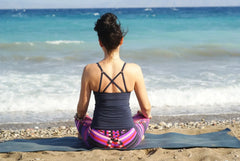
hours of the day—and for many of us, that means keeping clients and other people happy all the time. This can be emotionally taxing, which is why emotional rest is also important. To nurture your emotional body, take some “me time” on a regular basis in which you don’t worry about keeping other people happy, but instead do things that make you happy. This can include hobbies and sports (like surfing), reading a book, or simply sitting in the sun and enjoying some quiet time.
Related to emotional rest is social rest. Social media has made it so that we are constantly socializing with people, whether at work, at home, or on our devices. Some of these people feed us emotionally and socially, but others drain us—especially people who are demanding and needy, or who get on our nerves. It is important to take some time each day when you can detach from these socially exhausting people.
Finally, spiritual rest is important for each of us, even if we aren’t part of an organized religion. Spiritual rest can involve anything from attending church and praying to meditating or simply spending time in nature. For some of us, surfing is our spiritual rest—especially when we can enjoy a few waves by ourselves! This spiritual reboot helps us get back in touch with our authentic selves and remember the things that are most important to us.
As you can see, there are a number of different ways to rest, and all of them are important. Next time you are feeling worn down, take stock of your lifestyle and see where you are lacking rest. Taking a few minutes each day to rejuvenate your body, mind, and spirit can go a long way toward making you healthier and happier!
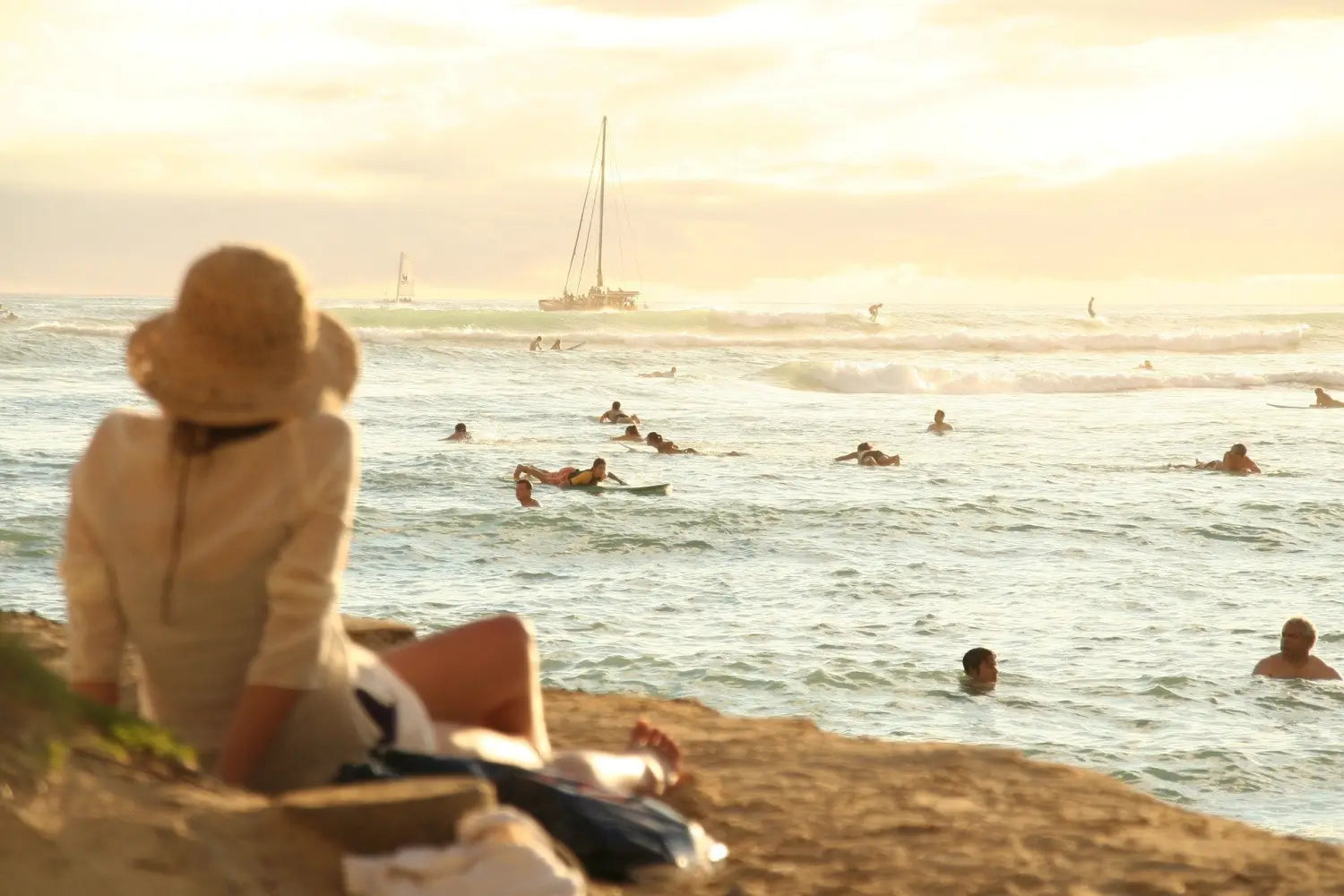
FIREWIRE BOARDS
For 2021 the following boards listed will not be stocked by Firewire. They are streamlining the factory. As you know it's been hard for them to get ahead of the curve.
So if you are looking for any of the following boards for spring/summer get your orders in now Orders typically are now taking 3 to 4 months.
That's actually pretty quick compared many otherbrands that I've talked to.
- Firewire FRK
- Firewire Gamma
- Firewire Hydronaut
- Firewire Hydroshort
- Firewire Midas
- Firewire SKX
- Firewire Go Fish
- Firewire Baked Potato
- Firewire Chumlee
- Firewire No Brainer
Mahalo for Checking our Newsletter! If you have questions you can text/call us at (808) 597-9055

